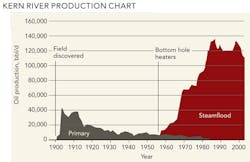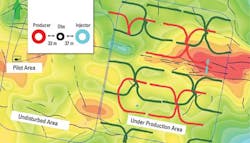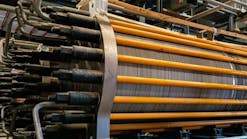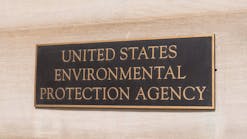EDITOR'S NOTE: This is the first in a series of thought leadership columns from key figures in the services sector of the oil and gas industry that look at the industry from their perspective and discuss where it is headed. Aaron Gatt Floridia is president of Schlumberger's reservoir characterization group. |
Aaron Gatt Floridia
Schlumberger
Paris, France
Increasing production from existing fields through EOR crucial to satisfying the world's energy needs
Ten years ago, Canada had just five billion barrels of proved oil reserves. Since then it has added a staggering 170 billion barrels of proven oil to the books--thanks to the successful deployment of highly efficient methods of "enhanced oil recovery" (EOR) in Canada's heavy oil deposits. As a result of a significant investment in EOR methods, Oman reversed a decade of plummeting oil production, boosting output from its mature fields by 17% between 2007 and 2009 alone.
As global demand for oil continues to rise, EOR is becoming increasingly important. To satisfy demand by 2015, for example, the industry will have to add new production capacity equivalent to twice the current oil production of Saudi Arabia. The industry may have to bring eight times that amount online by 2035 to meet projected demand. Where might that additional production come from? There are two ways to increase the global supply of crude: find new reserves, or boost recovery from known reservoirs.
The difficulty of making significant new discoveries continues to increase, while production from existing fields has been declining at twice the annual growth in demand. It is increasingly imperative for both national and international oil companies to extract substantially more oil from current producing assets. According to some estimates, even a 5% increase in average global recovery could yield as much new oil reserves as all future exploration activities.
Modern EOR techniques and emerging technologies not only increase recoverable oil reserves, but help sustain long-term production, and maximize return on investment throughout the life cycle of a reservoir or field. Producing more oil from a known reservoir is also environmentally prudent, and certain EOR practices can reduce greenhouse gas emissions. Having a well-planned and field-executed EOR strategy can lead to significant benefits.
What is enhanced oil recovery?
Unlike a lake or tank filled with water, a petroleum reservoir consists of solid rock containing microscopic pores or gaps between the grains, filled with oil or natural gas. The size and connectivity of these pores, the composition of the rock, the type and thickness of the fluid, the temperature of the formation, and many other properties of the reservoir determine how easily oil will flow towards the wellbore.
Pressure is one of the key factors. Buried beneath the earth, every reservoir is naturally under pressure. When a wellbore is drilled into the reservoir, higher pressure within the formation initially forces oil into the hole and up to the surface. Over time, however, the original pressure decreases and the flow of oil diminishes. Worldwide, the average amount of oil produced by simply drilling holes--known as "primary recovery--ranges from 10% to no more than 20% of the original oil in place.
To extract more oil from the same reservoir, operators must find ways either to restore formation pressure and/or to alter the oil's properties to enhance flow--typically by injecting various agents or materials that are not naturally present in the reservoir. Often, when primary production begins to wane, injection wells are drilled to flood the reservoir with water, maintaining pressure and sweeping additional oil into adjacent producing wells. Known as "secondary recovery," water flooding operations have raised average global recovery to 25 or 35%. However, these conventional techniques still leave 60% or more of the oil in the ground.
Over the past 60 years, the industry has developed even more sophisticated and effective, methods of displacing oil and improving recovery. Today, most enhanced oil recovery operations--previously called "tertiary recovery," but no longer relegated to the end of the oilfield life cycle--use one of the following schemes: gas floods (e.g. CO2, nitrogen, or hydrocarbon gas), chemical floods (e.g. surfactants, alkalines or polymers), or thermal methods (e.g. steam or fire floods).
The impact and scope of EOR operations
To understand the economic potential of EOR, consider the Kern River field of California. Thick, viscous (i.e. "heavy") oil was discovered in 1899. Primary production peaked within five years at around 40,000 barrels of oil per day (bopd), recovering a mere 5 to 10% of estimated oil in place. Production slowly declined for the next five decades. Just when many expected the field to be abandoned, a series of experiments in EOR dramatically turned things around.
In the late 1950s, bottomhole heaters were installed to soften the oil, followed by hot water injection in the early '60s. These early thermal methods boosted recovery to almost 25%. Beginning in 1964, more efficient steam flooding raised oil recovery to an estimated 60%, improving and sustaining production over the next 30 years. Oil production topped out at 140,000 bopd a full 80 years after the original peak in primary production. After yielding more than 2 billion barrels of oil, the Kern River field is still producing, thanks to EOR methods.
Chemical flooding, also first tested in the '60s, became the focus of industry research and experimentation during the '80s, after the oil crises of the '70s. Following an initial flurry of EOR activity, however, industry interest fell off throughout the '90s, due to low oil prices. After 2000, there was renewed interest in EOR as both prices and demand rose again, while production from mature fields declined worldwide. This led to new research and investments for better development of EOR techniques. A recent survey indicates that North America still dominates global EOR activity, followed by Asia and the Middle East, Europe, and Latin America.
Canada's Weyburn field--site of the world's largest CO2 injection and sequestration project--has successfully boosted incremental recovery from 12 to 20% since 2000, and extended field life about 25 years. Annually the project stores more than two million tons of CO2 underground, which is equivalent to removing 476,000 cars from the roads every year.
In the North Sea, Statoil's application of hydrocarbon gas flooding and alternating gas and water injection methods has increased oil recovery in some reservoirs beyond 50%. In Abu Dhabi, Total's combination of multi-lateral wells and hydrocarbon gas injection has achieved comparable results. In its first full-scale polymer flood, Petroleum Development Oman (PDO) more than doubled its oil recovery rate. Between 2005 and 2011, PDO's first full-field steam flood increased daily production by more than 16 times in another field, exceeding 100,000 bopd for the first time.
Today, China National Petroleum Corporation has many oilfields under steam or chemical injection. At Daqing, the country's largest oil field, widespread EOR operations have raised oil recovery to an estimated 47.5% and added 4.4 billion barrels of recoverable oil. These are just a few examples of the value and scope of enhanced oil recovery operations today.
New ideas and emerging EOR technologies
Despite their enormous potential financial impact on the bottom line, all EOR schemes come with additional costs, as well as technical and logistical complexities. In fact, all production methods after "primary recovery" come with an additional cost that needs to be mitigated by incremental oil production. The price tag for a large EOR field implementation is similar to the cost of a major deepwater development project. The Kern River field, for example, has more than 15,000 injection and production wells. From a technical perspective, EOR initiatives require exhaustive reservoir characterization, meticulous design, realistic pilot testing in a portion of the field, reliable monitoring, and thorough evaluation prior to deciding whether or how quickly to scale up the implementation.
Until recently, EOR was often seen as a luxury or a last resort method to extend the life of an asset. Forward-thinking oil companies are currently starting end-to-end life cycle planning earlier in the field's development. Starting a field development project with enhanced recovery in mind can minimize uncertainties, reduce cycle time, and prevent unnecessary reservoir damage during primary and secondary recovery operations. Extensive reservoir and field measurements should be acquired and analyzed. Gathering and modeling data along the full life of the reservoir is a very effective means of improving reservoir understanding.
Emerging technologies are playing an important role by enabling EOR to overcome technically challenges in a commercially viable manner. The following are three areas of recent advancement.
Advanced reservoir characterization. To make intelligent decisions throughout complex EOR projects and dramatically improve recovery over the long term, operators must understand oil reservoirs in greater detail. Teams of experts across multiple domains must integrate geochemical, geomechanical, geophysical, petrophysical, and other measurements at scales ranging from microscopic grains and pores to the entire field. It is essential, in other words, to characterize reservoirs with EOR in mind.
EOR-grade reservoir characterization requires increasingly more sophisticated reservoir models and fluid flow simulations than traditional characterization. In addition, these models must continually evolve as new laboratories, wells, and field data become available. Historically, EOR projects employed technologies originally developed for other applications. More recently, energy companies and oilfield service providers have begun joint research and development of unique technologies designed specifically for EOR. Shell and Schlumberger, for example, have collaborated on high-resolution digital representations of reservoir rocks to examine and create new methods of oil displacement and recovery.
EOR selection and design software. In the past, many EOR projects failed due to inadequate determination of the best EOR method for a particular field. Lacking extensive EOR experience, many operators resorted to overly simplistic rules of thumb based on published literature, without sufficient modeling or simulation. That generally failed to account for all the nuances of real reservoirs. Unique new EOR software technology now provides expert guidance in evaluating whether a field is an appropriate candidate for EOR, whether enough data is available to design an effective EOR pilot, and which EOR technique would displace more oil and produce the best results. Supplemented by a knowledge base of approximately 3,000 EOR projects worldwide, this smart advisor system incorporates laboratory results and evolving EOR-grade reservoir models to screen and design better pilot projects.
EOR field technologies. To determine if EOR laboratory tests and computer simulations are effective in the real world, it is also critical to implement small-scale pilot projects in the field. Traditionally, testing an EOR scheme required half a dozen or more injection and/or production wells, and often three to five years to complete. Under today's rapidly changing economic conditions, this is much too long and costly for most projects to come to fruition.
New EOR pilot technologies are dramatically accelerating EOR evaluations. A micro-scale pilot can measure the displacement efficiency of a particular EOR method in a tiny portion of a reservoir, by alternately injecting and producing from a single well over a few months. A medium-scale pilot, on the other hand, might take more than a year, requiring at least one injector, one producer, and an observation well in between.
For example, running such a pilot in an undisturbed part of a producing field enabled the national oil company of Abu Dhabi to evaluate the economic potential of CO2 flooding. Gathering extensive data from the wells to thoroughly document fluid behavior took about six months. Before deciding whether to expand the EOR program to other parts of the field, the company learned that several modifications would improve oil recovery. Modern EOR pilot projects depend on increasingly accurate, cross-well monitoring and imaging technologies to detect the arrival of fluid fronts, calculate oil and EOR fluid saturation levels, refine EOR well spacing and ensure optimal recovery over time.
The promise and future of EOR
In summary, the term "enhanced oil recovery" refers to methods in which gas, chemicals, heat, and other agents are administered at strategic points within a producing reservoir to mobilize oil reserves otherwise unrecoverable by traditional means.
EOR projects in the upstream oil industry are complex, and time-consuming, yet potentially extremely rewarding. Hence, operators and oilfield service companies are aggressively developing new tools and techniques to streamline and accelerate EOR processes. Even small improvements in oil recovery could potentially liberate millions of barrels worldwide.
Historically, although EOR methods have been applied primarily to conventional resources, today's shale oil plays also suffer from recovery limitations. Therefore, in the near future, it is likely that emerging EOR technologies will equally be used to increase reserves, sustain longer-term production, and maximize return on investment from unconventional resources. OGFJ
About the Author
Aaron Gatt Floridia is president of Schlumberger's reservoir characterization group, a position he assumed in July 2011. Prior to his current role, he held various global management positions including president for Schlumberger Middle East; general manager for WesternGeco's electromagnetics business; and previously, technology center manager for integrated productivity and conveyance. Earlier in his Schlumberger career, Gatt Floridia was wireline vice president for the Europe/Africa region after holding management and engineering positions in France, China, Saudi Arabia, the United Kingdom, and the United States. He began his career with Schlumberger in 1991 in wireline operations in Europe. Gatt Floridia holds a Bachelor of Science degree in chemical engineering from the University of Malta.





